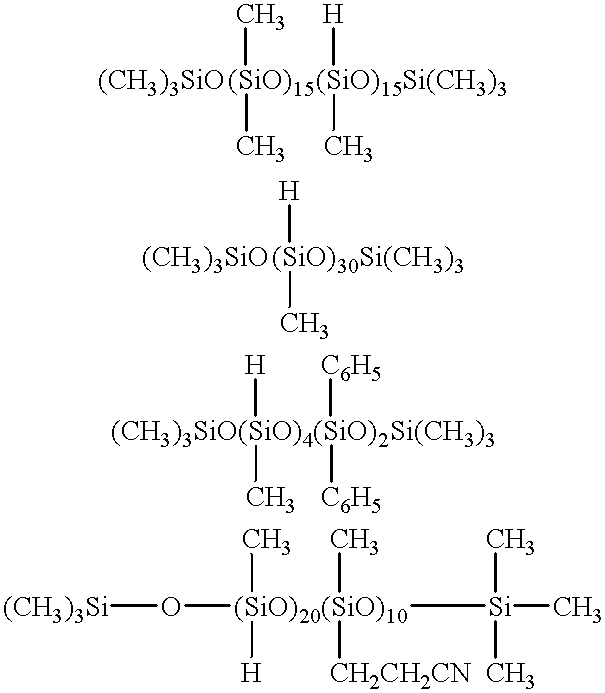Rubber composition
- Summary
- Abstract
- Description
- Claims
- Application Information
AI Technical Summary
Benefits of technology
Problems solved by technology
Method used
Image
Examples
examples 1 to 3
, Comparative Example 1 (Standard Example), and Comparative Examples 2 to 3
In these Examples, the ingredients of the formulations shown in Table 1 except for the vulcanization accelerator and the sulfur were charged into a 1.8 liter capacity internal mixer and kneaded for 3 to 5 minutes. The mixture was discharged when reaching a temperature of 120.+-.5.degree. C. The vulcanization accelerator and sulfur shown in Table 1 were kneaded with this master batch by an 8 inch open roll to obtain the rubber composition for footwear. The unvulcanized physical properties of the rubber composition for footwear thus obtained were measured.
Then, the rubber composition for footwear was placed in a 15.times.15.times.0.2 cm mold and press vulcanized at 140.degree. C. for 15 minutes to prepare a test piece (rubber sheet) which was used for measurement or evaluation of the vulcanized physical properties and abrasion resistance. The results are shown in Table 1.
examples 4 and 5
, Comparative Example 4 (Standard Example 2), and Comparative Example 5
In the Examples, the same procedure was followed as in Example 1 except for use of the formulations shown in Table 2 to prepare rubber compositions for footwear. The unvulcanized physical properties, vulcanized physical properties (vulcanization temperature: 140.degree. C., vulcanization time: 15 minutes), and abrasion resistance were measured or evaluated. The results are shown in Table 2:
examples 6 and 7
, Standard Example 3 (Comparative Example 5), and Comparative Examples 6 and 7
In the Examples, the same procedure was followed as in Example 1 except for use of the formulations shown in Table 3 to prepare rubber compositions and obtain rubber compositions for conveyor belt covers. The unvulcanized physical properties, vulcanized physical properties (vulcanization temperature: 150.degree. C., vulcanization time: 30 minutes), and abrasion resistance were measured or evaluated for the rubber compositions for conveyor belt covers obtained. The results are shown in Table 3:
PUM
| Property | Measurement | Unit |
|---|---|---|
| Fraction | aaaaa | aaaaa |
| Fraction | aaaaa | aaaaa |
| Percent by mass | aaaaa | aaaaa |
Abstract
Description
Claims
Application Information
 Login to View More
Login to View More - R&D
- Intellectual Property
- Life Sciences
- Materials
- Tech Scout
- Unparalleled Data Quality
- Higher Quality Content
- 60% Fewer Hallucinations
Browse by: Latest US Patents, China's latest patents, Technical Efficacy Thesaurus, Application Domain, Technology Topic, Popular Technical Reports.
© 2025 PatSnap. All rights reserved.Legal|Privacy policy|Modern Slavery Act Transparency Statement|Sitemap|About US| Contact US: help@patsnap.com



